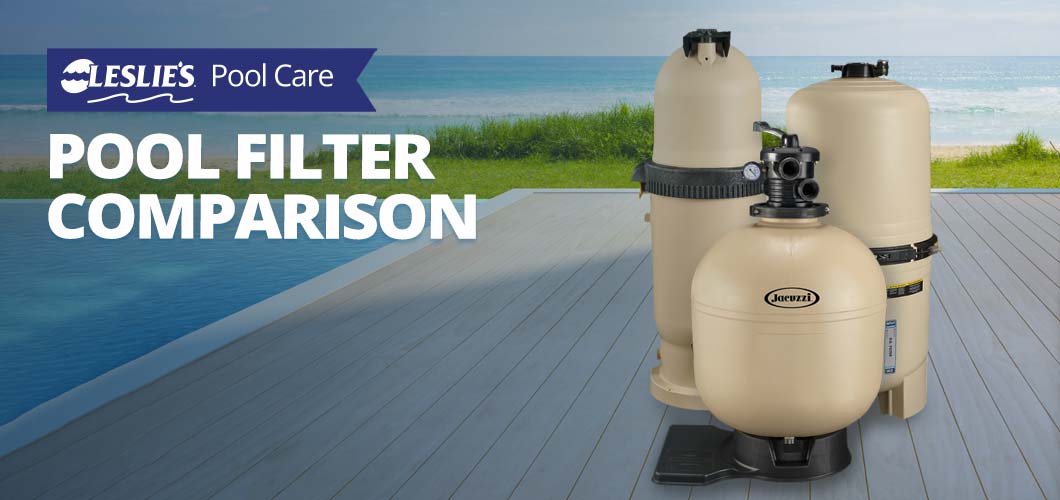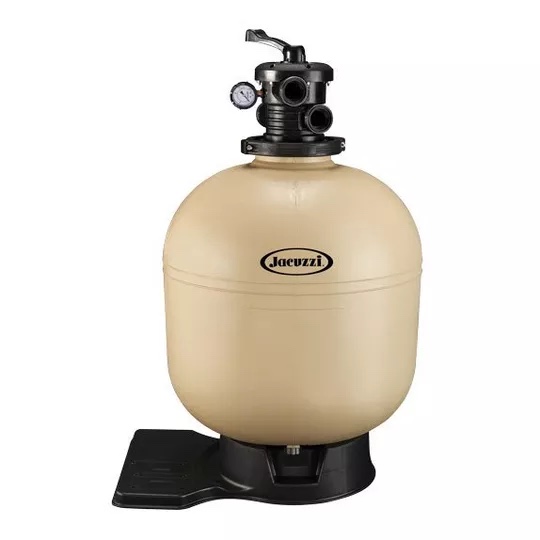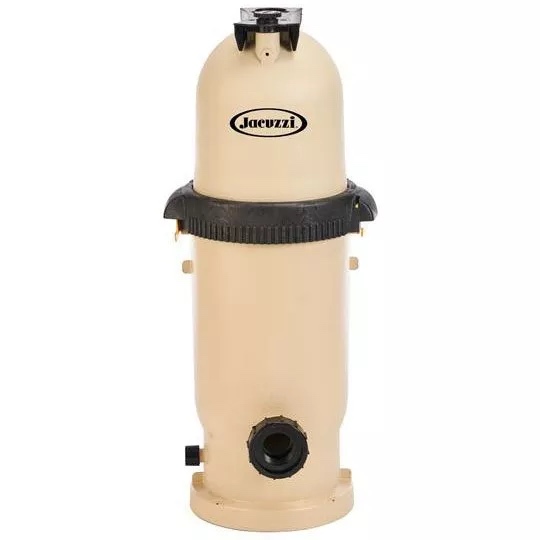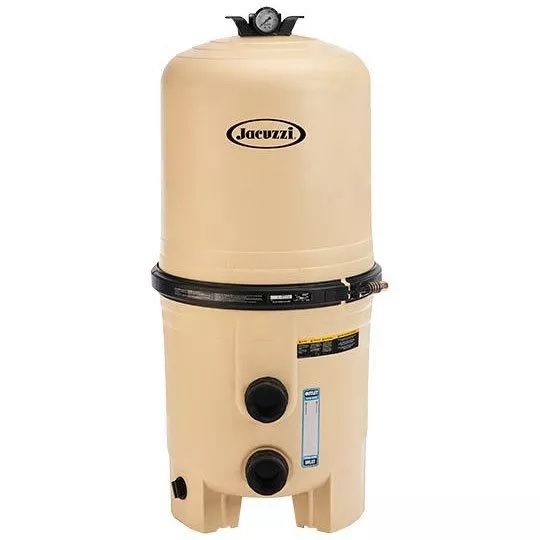
Pool Filter Comparison: Which One Should I Buy?
When it comes to choosing a filter for your swimming pool, there are many factors to consider. Things like maintenance requirements, initial expenses, upkeep, cleaning efficiency, pool size, and operating costs generally come to mind. In the end, perhaps the most important question to consider in your pool filter comparison is which type will work best for you and your budget. To answer that question, it’s most helpful to understand the differences between the three different styles of pool filters: sand, cartridge, and diatomaceous earth. Knowing the variances between these filters will help you better weigh your options.
Sand Pool Filters
Sand filters are large tanks filled with pool filter sand, working with the filter system to remove debris as small as 20–40 microns. There are also a few accepted filter media alternatives — including filter glass and Zeo sand — to increase your filtration power and remove debris within a smaller micron size range. The pump pushes water from the pool through the sand inside the tank, where the water is filtered and cleaned before returning to the pool. The initial purchase cost is much less than other types of filters, and the maintenance required is relatively low.
Over time, the accumulation of dirt and debris will build up pressure within the tank. When the tank’s pressure gauge reads 8–10 psi higher than where it started, all you have to do is run a backwash and rinse cycle to clear the filter. The filter sand itself holds up rather well, and only needs to be replaced every 3–5 years —or even longer with good care — which saves time and money for the user. Alternative filter media tends to be pricier, but offers superior filtration, and will usually last just as long, if not longer, than traditional pool sand. You may need to backwash the filter more often with alternative sand media, because it's able to trap more debris in the pool.

PROS:
- Lowest purchase price
- Traps debris particles as small as 20 microns
- Easy to operate and maintain
- Filter sand lasts around 3–5 years, or longer with good care
- Alternative filter media available to boost filtration power
- Popular option for both inground and above ground pools
CONS:
- Backwashing and rinsing process wastes water
- Some local regulations restrict backwashing
- Micron size filtered by sand (20 microns) is higher than other filters
- High pressure systems can decrease energy efficiency and increase wear on pumps
Cartridge Pool Filters
The tanks in cartridge filters are generally narrower and taller than sand filters, which is appealing to pool owners with a smaller filter pad. Cartridge filters offer high filtration performance in an energy-efficient, water-conserving, eco-friendly package. A cylindrical filter cartridge sits within the tank, which filters water through its pleated paper-like surface before the water returns to the pool. The cartridge design offers several benefits. Pleats increase the surface area available for capturing fine dirt and debris (often around 10–20 microns). This design lowers flow resistance in the system and ensures maximum pump efficiency, which can help save energy. In fact, cartridge filters work best at lower speeds, making them ideal for pairing with a variable speed pool pump.
Similar to the other filters, a pressure gauge reading of 8–10 psi higher than the starting pressure signals that it’s time to clean the cartridge. Although cartridge filters don’t require backwashing, which can save thousands of gallons a year, they still need to be thoroughly cleaned at least a couple times per season. This can be done by simply removing the cartridge from the tank and spraying it down with a hose, making sure to clean the areas between the pleats. A filter wand or "flosser" can make this task much easier. You can also soak the cartridge in a special cartridge cleaning solution to help eliminate stubborn dirt or stains. Repeated use will gradually decrease the filtration efficiency of your unit. Cartridges should be replaced every 2–3 years for best results.

PROS:
- Most energy efficient
- Reduces stress and wear on pool pump
- Filters debris as small as 10 microns
- Cartridges are easy to replace
- No backwashing required, which saves water
- Works well for both inground and above ground pools
CONS:
- Cartridges need to be replaced every 2–3 years
- Cleaning process is more hands-on
- Higher purchase price
- Not ideal for large or commercial pools
Diatomaceous Earth Pool Filters
Diatomaceous earth filters, also known as DE filters, offer superior levels of filtration — as small as 3 microns. DE is a naturally occurring sedimentary rock made from the fossilized exoskeletons of diatoms, a type of micro-algae. This rock crumbles easily and is used with pool filters in its powdered form. DE powder works by clinging to a series of grids/fingers within the unit’s large tank. This forms a thin, cakey layer that captures even the smallest debris from your pool. Although DE filters offer better filtration, they do require more frequent maintenance, and they're more expensive than sand or cartridge filters to buy and maintain.
Just like the other styles of filters, a pressure gauge reading of 8–10 psi above normal lets you know it’s time to clear the filter. Unlike sand filters, DE filters require an additional step after the backwashing process is complete. Every time the filter is cleaned or backwashed, you'll have to add more powder to the filter. This can be a bit more costly and require more maintenance time, depending on cleaning frequency. Most pools require backwashing at least once a month with moderate pool usage. Adding DE powder is simple, though — just pour the DE powder into the skimmer. In addition to routine backwashing, the entire unit should be broken down and thoroughly cleaned at least once or twice a year.

PROS:
- Filters debris as small as 3 microns
- Easy to replace DE powder
- Often used for inground pools, but above ground models are available
CONS:
- Highest purchase price
- Higher maintenance levels
- New DE powder needs to be added after each backwash
- Requires thorough cleaning once or twice per year, in addition to regular backwashing
- DE, in powder form, is carcinogenic if inhaled
- Some local regulations restrict backwashing
It’s important to consider all the pros and cons of each filter type before making your investment. When it comes to the pool pump you’re pairing it with, the general rule of thumb is that the filter’s GPM (gallons per minute) flow rate should be higher than the pump’s GPM to avoid damage to your filtration system. It’s usually best to opt for a larger filter than your pool actually requires. Regardless of which type you choose, purchasing a quality filter will help keep your pool sparkling all season.